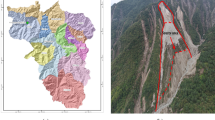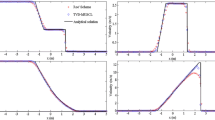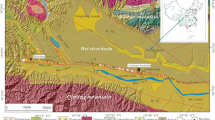Abstract
When the safety factor of natural or artificial slopes reaches critical value of 1.0, the increment of triggering factors, i.e. precipitation, rise of groundwater level, earthquake, and slope interference may prompt slope failure. Considering the impacts and damages possibly caused by rapid landslides, it is important to predict its runout distance, velocity, moving volume, and coverage area. A numerical model was developed to calculate the rapid landslide motion and applied to 26 cases of landslides and 6 cases of debris flows, with volume ranging from less than 100 m3 up to 3.5 × 109 m3. This quasi-three-dimensional model used the Navier–Stokes equation as the governing equation of motion and Coulomb’s resistance rule along the sliding surface to compute runout distance and coverage area corresponding with the real rheological conditions in the field. Due to the influence of dynamic conditions and excess pore water pressure, the internal friction of the sliding mass and the sliding surface are much smaller than the internal friction obtained by static soil tests. The moving volume affects the dynamic coefficient of friction and the velocity, whereas a small volume landslide occurs at a higher value of dynamic coefficient of friction and yields lower velocity. In addition, a landslide with a gentler slope occurs at a lower value of dynamic coefficient of friction, where in the case of the debris flow, it tends to have an even lower dynamic friction compared to landslide. This numerical model can be used to simulate the motion of rapid landslides with potentially long run-out in order to support hazard and risk assessment of landslides.












Similar content being viewed by others
References
Bossi G, Cavalli M, Crema S, Frigerio S, Quan Luna B, Mantovani M, Marcato G, Schenato L, Pasuto A (2015) Multi-temporal LiDAR-DTMs as a tool for modelling a complex landslide: a case study in the Rotolon catchment (eastern Italian Alps). Nat Hazards Earth Syst Sci 15:715–722
Bronto S (2001) Volcanic debris avalanches in Indonesia. In: Proceedings of the 3rd Asian symposium on engineering geology and environment, Yogyakarta, Indonesia 3–6 September 2001, pp 449–462
Bronto S (2006) Fasies gunung api dan aplikasinya. J Geol Indones 1(2):59–71 (in Indonesian)
Crosta GB, Imposimato S, Roddeman DG (2003) Numerical modelling of large landslides stability and runout. Nat Hazards Earth Syst Sci 3:523–538
Cruden DM, Varnes DJ (1996) Landslide types and processes. In: Landslides, investigation and mitigation. Special Report 247, Transportation Research Board, Washington, pp 36–75
Dang K, Sassa K, Fukuoka H, Sakai N, Sato Y, Takara K, Quang LH, Loi DH, Tien PV, Ha ND (2016) Mechanism of two rapid and long-runout landslides in the 16 April 2016 Kumamoto earthquake using a ring-shear apparatus and computer simulation (LS-RAPID). Landslides. doi:10.1007/s10346-016-0748-9
Egashira S, Miyamoto K, Itoh T (1997) Constitutive equations of debris flow and their applicability. Debris-Flow Hazards Mitigation, Water Resources Engineering Division/ASCE, pp 340–349
Fathani TF (2006) The analysis of earthquake-induced landslides with a three-dimensional numerical model. In: Proceedings of Geotechnics symposium, Yogyakarta, Indonesia, pp 159–165
Fathani TF, Suryolelono KB, Suhendro B, Legono D (2001) Numerical analysis on the reach and velocity of landslide movements. J Forum Tek 25(3):354–363
Hungr O (2007) Dynamics of rapid landslides. In: Sassa K, Fukuoka H, Wang F, Wang G (eds) Journal of progress in landslide science. Springer, Berlin, pp 47–57
Hungr O (2009) Numerical modelling of the motion of rapid, flow-like landslides for hazard assessment. KSCE J Civ Eng 13(4):281–287
Iverson RM (2012) Elementary theory of bed-sediment entrainment by debris flows and avalanches. J Geophys Res 117:F03006. doi:10.1029/2011JF002189
Iverson RM, Denlinger RP (2001) Flow of variably fluidized granular masses across three dimensional terrain. 1. Coulomb mixture theory. J Geophys Res 106(B1):537–552
Johnson CG, Kokelaar BP, Iverson RM, Logan M, LaHusen RG, Gray JMNT (2012) Grainsize segregation and levee formation in geophysical mass flows. J Geophys Res 117:23. doi:10.1029/2011JF002185
Knill J (1996) Report on the Shum Wan Road Landslide of 13 August 1995. Landslide investigation by the Geotechnical Engineering Office, Civil Engineering and Development Department. Hong Kong. http://www.cedd.gov.hk/eng/publications/geo/geo_swr.html. Accessed March 2016
Lang YH, Nakamura H (1998) Characteristics of slip surface of loess landslides and their hazard area prediction. J Jpn Landslide Soc 35(1):9–18
Mangeney A, Bouchut F, Thomas N, Vilotte JP, Bristeau MO (2007a) Numerical modeling of self-channeling granular flows and of their levee-channel deposits. J Geophys Res 112:F02017. doi:10.1029/2006JF000469
Mangeney A, Tsimring LS, Volfson D, Aranson IS, Bouchut F (2007b) Avalanche mobility induced by the presence of an erodible bed and associated entrainment. Geophys Res Lett 34:L22401
McDougall S, Hungr O (2004) A model for the analysis of rapid landslide motion across three-dimensional terrain. Can Geotech J 41:1084–1097
Miyamoto K (2010) Numerical simulation of landslide movement and Unzen-Mayuyama disaster in 1792, Japan. J Disaster Res 5(3):280–287
Nakamura H, Tsunaki R, Ishihama S (1989) Simulation model for debris movement of landslides. In: Proceedings of the Japan–China symposium on landslides and debris flows, Niigata - Tokyo, pp 81–86
Nakamura H, Fathani TF, Karna AK (2002) Analysis of landslide debris and its hazard area prediction. In: Proceedings of the international symposium on landslide mitigation and protection of cultural and natural heritage, Kyoto, Japan, pp 173–189
Pastor M, Haddad B, Sorbino G, Cuomo S, Drempetic V (2009) A depth-integrated coupled SPH model for flow-like landslides and related phenomena. Int J Numer Anal Methods Geomech 33:143–172
Pastor M, Blanc T, Haddad B, Petrone S, Sanchez M, Drempetic V, Issler D, Crosta G, Cascini L, Sorbino G, Coumo S (2014) Application of a SPH depth-integrated model to landslide run-out analysis. Landslides 11(5):793–812
Pelanti M, Bouchut F, Mangeney A (2008) A Roe-type scheme for two-phase shallow granular flows over variable topography. ESAIM Math Model Numer Anal 42(05):851–885
Pitman EB, Le L (2005) A two-fluid model for avalanche and debris flows. Philos Trans A Math Phys Eng Sci 363:1573–1601
Pudasaini SP (2012) A general two-phase debris flow model. J Geophys Res 117:F03010. doi:10.1029/2011JF002186
Quan Luna B, Cepeda J, Stumpf A, van Westen CJ, Remaitre A, Malet J-P, van Asch TWJ (2013) Analysis and uncertainty quantification of dynamic run-out model parameters for landslides. In: Margottini C et al (eds) Landslide science and practice, vol 3. Springer, Berlin, pp 315–318
Rickenmann D (1999) Empirical relationships for debris flows. Nat Hazards 19:47–77
Roessner S, Wetzel H-U, Kaufmann H (2005) Sarnagoev A (2005) Potential of Satellite Remote Sensing and GIS for Landslide Hazard Assessment in Southern Kyrgyzstan (Central Asia). Nat Hazards 35:395–416
Sassa K, Nagai O, Solidum R, Yamazaki Y, Ohta H (2010) An integrated model simulating the initiation and motion of earthquake and rain induced rapid landslides and its application to the 2006 Leyte landslide. Landslides 7(3):219–236
Sosio R, Crosta GB, Hungr O (2012) Numerical modeling of debris avalanche propagation from collapse of volcanic edifices. Landslides 9:315–334
Voight B, Janda RJ, Glicken H, Douglass PM (1983) Nature and mechanics of the Mount St. Helens rockslide-avalanche of 18 May 1980. Geotechnique 33:243–273
Wang W, Chen G, Han Z, Zhou S, Zhang H, Jing P (2016) 3D numerical simulation of debris-flow motion using SPH method incorporating non-Newtonian fluid behavior. Nat Hazards 81(3):1981–1998
Ward SN, Day S (2006) Particulate kinematic simulations of debris avalanches: interpretation of deposits and landslide seismic signals of Mount Saint Helens, 1980 May 18. Geophys J Int 167(2):991–1004
Yang C-M, Yu W-L, Dong J-J, Kuo C-Y, Shimamoto T, Lee C-T, Togo T, Miyamoto Y (2014) Initiation, movement, and run-out of the giant Tsaoling landslide—What can we learn from a simple rigid block model and a velocity–displacement dependent friction law? Eng Geol 182:158–181
Acknowledgements
We would like to show our gratitude to Prof. Hiroyuki Nakamura for his leadership and supervision in the development of the simulation model. We also thank Mr. Refi Noer Fauzan and Ms. Monika Aprianti Popang for their technical assistance.
Author information
Authors and Affiliations
Corresponding author
Rights and permissions
About this article
Cite this article
Fathani, T.F., Legono, D. & Karnawati, D. A Numerical Model for the Analysis of Rapid Landslide Motion. Geotech Geol Eng 35, 2253–2268 (2017). https://doi.org/10.1007/s10706-017-0241-9
Received:
Accepted:
Published:
Issue Date:
DOI: https://doi.org/10.1007/s10706-017-0241-9




